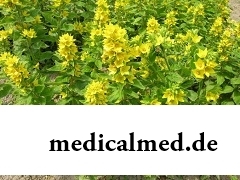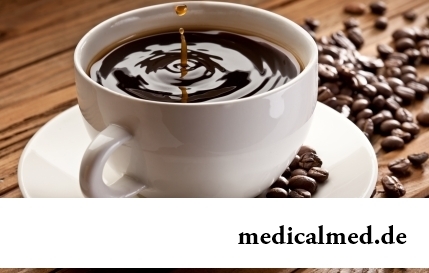





Loosestrife
Application instruction:
Loosestrife – the perennial or biannual herbaceous plant belonging to family of the Primrose family.
 In the wild nature the plant prefers wet meadows, swamps and coastal water spaces. Blossoms at the end of June. Thickets of this plant can be met across all Europe, on the Crimean peninsula, in Russia, in Central Asia and in the Caucasus.
In the wild nature the plant prefers wet meadows, swamps and coastal water spaces. Blossoms at the end of June. Thickets of this plant can be met across all Europe, on the Crimean peninsula, in Russia, in Central Asia and in the Caucasus.
Loosestrifes meet the leaves creeping on the ground or with high upright, leaved, escapes. Flowers at a plant of usually yellow color, but happen views with white flowers, small campaniform, are collected in pyramidal inflorescences. Inflorescences quite large also occupy nearly a half of an upper part of escape.
Cultivation of a loosestrife
Cultivation of a loosestrife is widespread in decorative gardening. Preferential gardeners grow up a loosestrife of three types – monetchaty, dot and ordinary.
Upright stalks have a dot and ordinary loosestrife. The loosestrife ordinary is quite high plant, its height can reach one and a half meters. Has inflorescences yellow, in the form of whisks. The dot loosestrife is approximately twice lower also than its inflorescence, connecting together, form a verticil of 4 pieces. These species of plants love wet solar places and well trained soil. At observance of these conditions of a plant will blossom on an extent of all summer period.
The Monetchaty loosestrife has escapes creeping, in length not exceeding half-meter. Inflorescences are quite large, grow from sheet bosoms. This species of a plant is very unpretentious and drought-resistant, quickly expands and perfectly feels in a half-shade or a shadow.
Useful properties of a loosestrife
In traditional medicine the loosestrife ordinary, thanks to the high content of ascorbic acid and saponins most was widely adopted. The Monetchaty loosestrife known also under the name tea meadow, is used in the form of tincture at some diseases.
The plant has a set of useful properties in medicine: the anesthetic knitting, styptic and wound healing. However in official medicine medicinal properties of this plant are not applied. But they found the application in traditional medicine and homeopathy.
In traditional medicine it is used for elimination of symptoms of internal bleeding and a diarrhea. The healing property of tea from this plant is applied to treatment of long not healing and purulent wounds, and also at the milkwoman, eczema and stomatitis.
The loosestrife contains carbohydrates, tannins, Rutinum, saponins and silicon acid. During blossoming the plant contains a large amount of ascorbic acid.
The plant is collected together with roots and dried up in not solar well aired rooms. The grass is used for tea preparation. Leaves and flowers fray and do of them mix which is applied to treatment of abscesses. Also on wounds impose fresh leaves of a plant. Do powder which is used as wound healing and an anesthetic of roots of a plant.
Contraindications to use of a loosestrife
It is forbidden to use a loosestrife at the increased coagulability of blood, and also at such diseases as an angiosclerosis of extremities, varicosity, thrombosis. At a hypertension it is also contraindicated. Broths of a plant cannot be given for treatment of dry cough at children.
During sneezing our organism completely stops working. Even heart stops.

Use of medicinal plants in therapy is urgent today, more than ever. The drugs made of curative herbs cannot on...
Section: Articles about health
Subfebrile temperature call fervescence to 38 degrees, and subfebrile condition - existence of such temperature over 3 days, and quite often it happens without the visible reasons. Existence of subfebrile condition - a strong indication of disturbances in an organism which can...
Section: Articles about health
Reactive pancreatitis - the disease which is characterized by inflammatory process in a pancreas which arises most often because of excess activity of digestive enzymes. It − the emergency state which treatment has to take place in surgical department under control of doctors. The acute inflammation of gland can become the reason of its transition to a chronic form, and also development is purulent - necrotic pancreatitis which the extensive necrosis of fabrics can follow. Zabolev...
Section: Articles about health
Transfusion of donor blood has almost century history. In spite of the fact that this procedure is quite usual for many people, itself п...
Section: Articles about health
The immunity role in growth of the child is invaluable. The proteins-immunoglobulins produced by immune system preserve the child against the diseases capable − owing to an organism weak still − to serve as a stressful factor, to become the reason of many complications and delays in unless...
Section: Articles about health
80% of women at least once to lives complained of discomfortable feelings to breasts, consolidations and nagrubaniye. These are mastopathy symptoms. The mastopathy is characterized by change of a ratio between ferruterous and connective tissue tissues of mammary glands. It can lead to formation of cysts (a cystous mastopathy), gland consolidation (a fibrous mastopathy), or a combination of these processes (a fibrous and cystous mastopathy)....
Section: Articles about health
Each failure in work of bodies and systems of a human body is, as a rule, shown by the whole complex of symptoms. In particular, N...
Section: Articles about health
The popular expression "run from a heart attack" became the motto of the people supporting active lifestyle. Moreover, run became a peculiar fashionable tendency: sales of racetracks and the accompanying goods for run are at permanently high level. Really...
Section: Articles about health
The business lady, the become mother, it is necessary to solve an array of problems. But of them is main: how to combine the beloved child and work? What traps trap the working mother and how she needs to behave?...
Section: Slideshow
To look healthy and means well-groomed not only to be pleasant to people around, but also to feel strong, sure and taken place. To Spa...
Section: Articles about health
Coffee – favourite drink of many. For the last decades it more than once already declared very harmful, extremely useful and even necessary for normal life activity. In spite of the fact that this product became for us usual for a long time, exists much...
Section: Articles about health
The person, as well as all other beings living on our planet feels weather changing. It is the normal meteosensitivity which is not causing to healthy people of special troubles. Meteodependence, on the contrary, is the morbid condition which is characterized by an exacerbation of chronic illnesses at change of air temperature, differences of atmospheric pressure, wind strengthening, magnetic storms and other "surprises" on which the nature is so generous. The people suffering from meteodependence have to з...
Section: Articles about health
Cellulitis - very widespread cosmetic shortcoming which arises approximately at 80% of women sooner or later. Emergence ег...
Section: Articles about health
Water with a lemon - idle time in preparation drink which supporters of a healthy lifestyle already managed to appreciate. Used in a warm look and on an empty stomach, it is one of the most useful prophylactics allowing to prevent tens з...
Section: Articles about health
Among a set of the perfumery and cosmetic goods which are released today the special group is made by the means containing antibacterial components. Such types of gels, shampoos, soaps, creams, lotions and other products are positioned by manufacturers as a panacea from all diseases caused by pathogenic microorganisms. The unlimited and uncontrolled use of similar means becomes result of trustfulness of the buyers hypnotized by persuasive advertizing sometimes. Many spetsial...
Section: Articles about health
Sooner or later hair turn gray at all. Many people try to hide these changes, returning natural color of the hair with the help about...
Section: Articles about health
Neurosis is called pathology of a nervous system at which deviations in functioning of the highest nervous processes are observed. Most often - owing to yet not strengthened mentality - children are subject to neurosises. Premises to emergence of such disturbances can become нез...
Section: Articles about health
(Xerostomia) many people consider feeling of a xerostomia small and easily removable inconvenience. This delusion: the symptom can demonstrate existence of serious diseases. It is worth to remember also that saliva performs important functions in an organism: clears the surface of teeth of a food plaque, growth of pathogenic microorganisms oppresses, normalizes acid-base balance, liquefies food and helps to split the carbohydrates which are contained in it. Chronic deficit слюн...
Section: Articles about health
A lot of things depend on a condition of a backbone in a human body, a backbone - not only a support for a body, it also contain...
Section: Articles about health
Condition of lips (their morbidity, outward) – one of indicators of health of the person. The peeling, dryness, pallor, and also cracks in corners of a mouth can be not only the cosmetic shortcoming which arose owing to physical damages and weather having sent away...
Section: Articles about health
Weakness of an ankle joint – very widespread problem. Its existence is demonstrated by tendency to a podvorachivaniye of legs when walking on heels, frequent painful sprains, pain on average and anonymous toes even after small loadings. Usually people with such pathology take off unpleasant effects by means of the anesthetizing pulverizing and ointments, but it does not lead to radical elimination of a problem. Meanwhile, at the known persistence it is possible to strengthen an ankle to the house...
Section: Articles about health
Bees – really unique beings. Practically all products of their life activity are used by the person. Since the most ancient times from...
Section: Articles about health
Life activity of one-celled fungi of the sort Candida, related to yeast is a proximate cause of development of candidiasis (milkwoman). Normal these microorganisms are a part of the microflora living in an oral cavity and intestines of most of people, and that...
Section: Articles about health
Very often as a source of the infection which caused a disease serves our house - the place which a priori has to be safe. However disease-producing bacteria can perfectly feel not only in insanitary conditions, but also in our apartment if not to carry out due care of favourite places of their dwelling. What they − sources of their reproduction? Let's consider 10 most widespread places in our house, the most dangerous from the point of view of infection with microorganisms....
Section: Articles about health
Epilepsy is one of widespread neurologic diseases. To parents, whose children suffer from this illness, it is necessary...
Section: Articles about health
EKO, or extracorporal fertilization - a method of treatment of infertility which became the reason of a set of broken-down copies in due time accused the people working on its creation neither more nor less of rivalry good luck. Already very few people deny the rights...
Section: Articles about health
The endocrine system carries out extremely important role in a human body, practically all processes of life activity are regulated by it. Closed glands (hemadens) produce special biologically active agents – hormones which then get to a blood channel and are transferred to bodies addressees, or as they are called still, to target organs. Frustration of this mechanism are fraught with development of serious chronic pathologies....
Section: Articles about health
